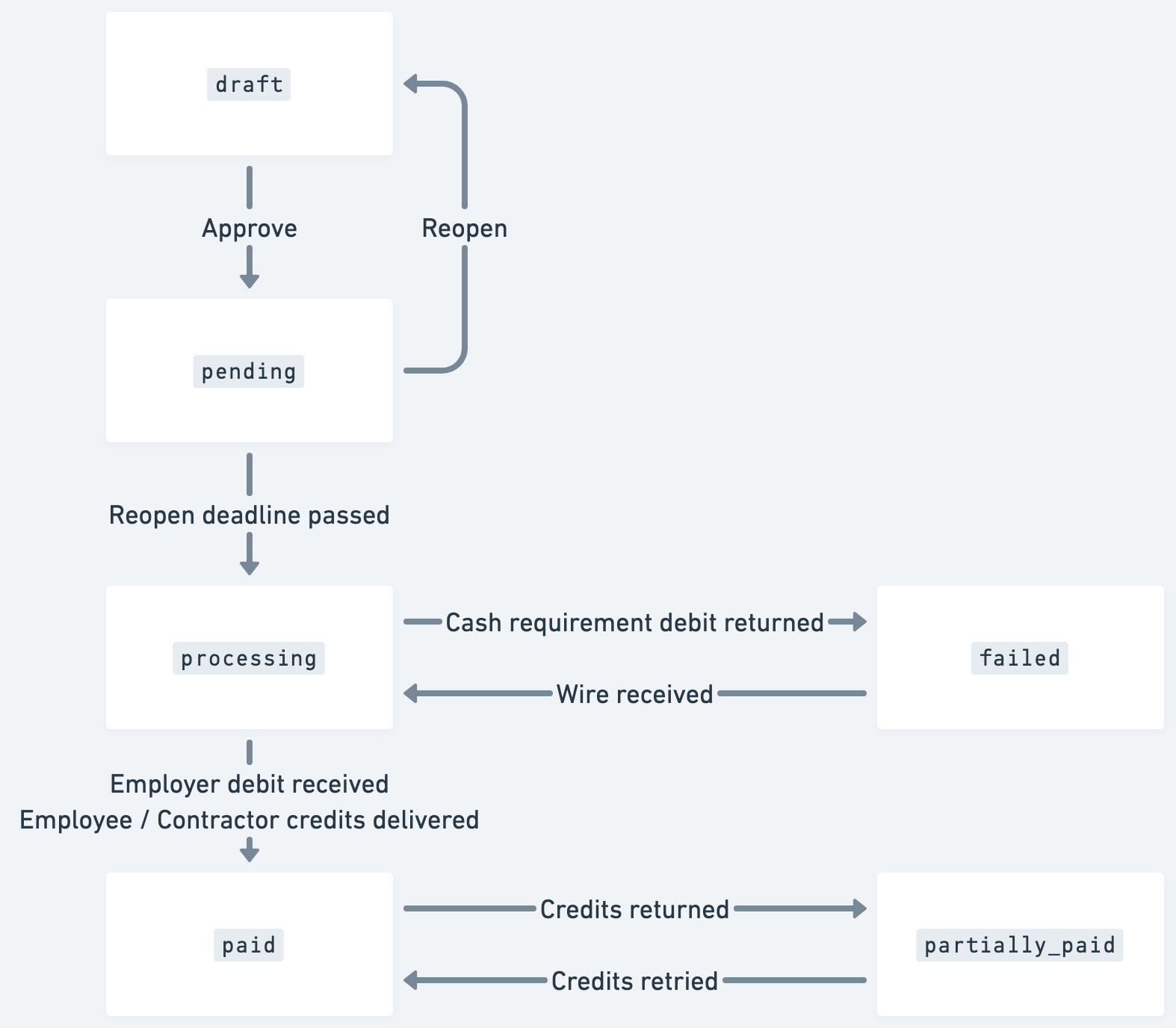Payroll Status
Stages in the lifecycle of a Payroll
Once a payroll is approved, Check will automatically collect funds from the employer's bank account, make sure wages are transferred into employees' bank accounts on payday, and remit tax payments on time. We handle all of this behind the scenes, but you will still want to keep tabs on your payroll as it moves through each phase of its lifecycle.
Check surfaces status information on the payroll objects returned by our API through the status field. A payroll can have one of five (5) statuses: draft, pending, processing, paid, or partially_paid. Below is an overview of these statuses, what they mean, and how payrolls transition between them.
Payroll status webhooksWhen a payroll transitions between statuses, you can receive webhook notifications from our platform. See the webhook documentation for more details about how to set this up.
Payroll Status Lifecycle

draft
draftWhen a payroll is first created, it will be in the draft status. You can modify a draft payroll in any way you see fit. Payments to employees can be added and removed, earnings and hours worked can be modified on individual payroll items, etc. You can only delete a payroll while it's in draft.
Certain fields like net_pay, taxes, and benefits are null on a draft payroll because they haven’t been calculated yet. In order to see what these fields would be set to based on the current configuration of the payroll, you can preview the payroll using the /payrolls/<payroll_id>/preview endpoint. This causes our API to perform and surface the same calculations that will be performed when the payroll is approved, but does not change the status of the payroll.
Note that only draft payrolls can be previewed, and they can be previewed any number of times.
Historical Payroll ItemsPayroll Items related to historical Payroll objects will retain a status of
draft, even while their related Payroll may be inpaid, because they are not being pushed through the lifecycle outlined above.
pending
pendingWhen a payroll is approved (via the /payrolls/<payroll_id>/approve endpoint), its status changes to pending. Once pending, the payroll can no longer be modified or previewed. This is because the taxes, net pay, and benefits have been calculated and saved for the payroll.
If you need to modify a pending payroll, you can do so by reopening the payroll (via the /payrolls/<payroll_id>/reopen endpoint), which will move it back into the draft status. This action can be taken up until the reopen_deadline shown on the payroll, which is set automatically to the later of 11am ET on day of the payroll's approval_deadline or 1 hour after approval (but no later than the payroll's approval_deadline).
Sandbox BehaviorIn our sandbox environment, we automatically transition payrolls from
pendingtoprocessingtopaidevery five minutes. We do this to simulate the behavior of a payroll in production on a shorter time scale.
processing
processingAfter the reopen_deadline on the payroll passes, the payroll will automatically move to a processing status. This indicates that the payroll can no longer actioned upon, and it is now on Check to begin the multi-step process of moving money through the banking system. If you require a change to a payroll in a processing status, reach out to us directly.
At the end of each business day at 5pm PT, our system collects all payrolls that have an approval_deadline on that day and begins processing payments for those payrolls. The first step in this process is to submit an ACH transaction to debit the cash requirement for a payroll from the employer’s bank account.
paid
paidDue to the nature of the ACH network, the employer debit transaction will take up to 3 business days to complete. For example, if you approve a payroll with a Friday payday on Monday, we should have the employer’s funds in our bank account by Thursday morning. Once Check has the employer’s cash requirement, we submit ACH transactions to send net pay to each employee who is set up for direct deposit.
When these transactions complete, the payroll enters its final status: paid. Once here, the employees' payments for your payroll have been sent out . The employees are happy, and employers can focus on their business!
partially_paid
partially_paidUnfortunately, there will be times when an ACH payment to an employee or a contractor is returned. This can happen for a number of reasons, but the most common is an invalid account/routing number or frozen bank account. In cases like these, it is important that you have insight into the exact state of the payments.
To handle this, Check will mark the returned payroll item or contractor payment as failed, and mark the parent payroll as partially_paid. This status means that we have attempted to send out employee or contractor payments and one or more of these payments failed. If you need to resolve a failure, please reach out to us directly. After the employee or contractor payment failure has been handled you will see the payroll's status flip back to paid.
failed
failedJust as we will unfortunately see times that an employee's payment will fail, there will also be times when the ACH transaction to debit the cash requirement for an employer's payroll will be returned. One common reason this occurs is because there are insufficient funds for the transaction in an employer's bank account at the time of request.
When this happens, Check sets the payroll's status to be failed and, if possible, pauses in-flight employee and contractor payments for that payroll. Our team then works with you to quickly wire the cash requirement for the failed payroll before unpausing and delivering the payroll's employee and contractor payments.
Testing sandbox failure behaviorFor more information on how to reach
failedandpartially_paidstatus in Sandbox, see our Payments Guide.
Updated about 1 month ago
